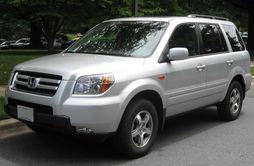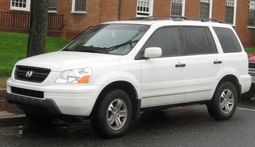The History Of Honda Pilot

The Honda Pilot is a mid-size SUV and is Honda's second SUV fully built and designed by Honda, released in the summer of 2002 for the 2003 model year to replace the body-on-frame Passport, which was a rebadged Isuzu Rodeo, which was sold only in the United States, although the Passport was Honda's first SUV sold from 1994-2002. The Honda Pilot is built in Lincoln, Alabama and was built in Alliston, Ontario, Canada up until April 2007. The Pilot is now built exclusively at the Lincoln, Alabama plant. The Pilot shares underpinnings and the powertrain with the Acura MDX, which has a lineage which can be traced to the Honda Odyssey minivan. The Pilot’s unibody construction, however, is fortified with integrated perimeter frame rails, which helps it withstand light off-road use.
The Pilot was designed to fill a large American demand for SUVs. Prior to the introduction of the Pilot, Honda only had the smaller CR-V based on the Civic, and the aforementioned Passport. However, the CR-V lacked in features many American consumers looked for in an SUV, which are overall size, passenger space, and towing capacity. The Pilot is at most designed to withstand light-duty off-roading.
The Pilot has been a best-seller for Honda, with Honda selling over 100,000 Pilots in 2004, an increase of almost 20% over 2003. For 2006, the Pilot received new front and rear fascias, a redesigned interior, and various standard safety features.
The Pilot is sold in North America, while Japan and Australia get its relative, the Honda MDX instead. In the Middle East, the Pilot is sold as the Honda MR-V. The second generation 2009 Pilot is also available in Russia and Ukraine.
Specifications
Like the first-generation MDX, the Pilot is propelled by an aluminum alloy 3.5 L SOHC, 24-valve VTEC V6 engine. The engine is rated at 240hp (179kW) and 242lb·ft (328N·m) of torque, and mated to a five-speed automatic, which, as tested, results in a 0-60 mph time of 7.6 seconds and 1/ 4 mile sprint of 15.9 seconds. For the 2007 model, the power was increased to 244hp (182kW), 240lb·ft (325N·m) of torque and includes a drive-by-wire throttle. The Pilot weighs in at a little over 4,400lb (1,996kg), with a United States Environmental Protection Agency (EPA) estimated gas mileage for 2007 of 16mpg-US (15L/ 100km; 19mpg-imp) city and 22mpg-US (11L/ 100km; 26mpg-imp) highway for the two wheel drive model, and 15mpg-US (16L/ 100km; 18mpg-imp) city and 20mpg-US (12L/ 100km; 24mpg-imp) highway for the four wheel drive model. Also, like the MDX, the Pilot rides on struts up front with a coil-spring, multilink arrangement at the rear designed to allow a flat load floor. It also has the MDX’s wide track — 66.3in (1684mm) at the front and 66.5in (1689mm) at the rear. The Pilot has a 4,500lb (2,041kg) boat/ 3,500lb (1,588kg) trailer towing capability.
Design
The Pilot is capable of transporting up to eight passengers. The third row seats 3 but legroom is limited, allowing transportation of small children or adults on short trips. Similar to the Honda Odyssey, the rear seats are capable of folding into completely flat surfaces to allow larger cargo inside if necessary. Seats are configured as stadium seating. Optional amenities that can also be included are a powered moonroof, DVD entertainment system, and a navigation system.
The Pilot employs a four-wheel drive system called Variable Torque Management 4WD (VTM-4). The VTM-4 system delivers power to all four wheels under acceleration and when wheel slippage is detected. The VTM-4 system has a dashboard switch that locks both rear half-shafts to get the driver unstuck, but it operates in just the first two gears and unlocks at 18mph (29km/ h). Otherwise, the system operates primarily in front-wheel drive and sends torque to the rear wheels when spin is detected up front. Two wheel drive models have been available since 2006.
The Pilot's safety mechanisms are the VTM-4 system, ABS-equipped four-wheel disc brakes, rack-and-pinion steering, four-wheel independent suspension and 282° of outward visibility. The foundation for the Pilot is a highly rigid unibody with reinforcing structures and energy absorbing crush zones. The Pilot's structure is designed to deform progressively in front, side and rear end collisions.
The new Pilot is available in four trims; LX, EX, EX-L, and Touring. Its assembly began in Lincoln, Alabama. It receives a new 3.5L V6 VTEC engine producing 250horsepower (190kW) SAE net at 5700 rpm and 253pound-feet (343N·m) of torque at 4800 rpm. EPA fuel economy is 17mpg-US (14L/ 100km; 20mpg-imp) city/ 23mpg-US (10L/ 100km; 28mpg-imp) highway for the front wheel drive transmission and 16mpg-US (15L/ 100km; 19mpg-imp) city/ 22mpg-US (11L/ 100km; 26mpg-imp) highway for the 4 wheel drive transmission. Both transmissions are five-speed automatics. The new wheelbase is 109.2 in (2774 mm), with an outside length of 190.9 in (4849 mm), a width of 78.5 in (1994 mm), a height of 71.0 in (1803 mm). Much of the interior has changed, receiving a tri-zone automatic climate control system, new two-position memory settings for the driver's seat, and a new power tailgate. The Touring trim offers a new 115-volt power outlet and a Satellite-Linked Honda Navigation System.
The Honda Pilot has a capable off-road system which comprises three individual systems: the Variable Torque Management four-wheel drive system with locking differential, Hill Start Assist Control system and Grade Logic Control system.
The 4WD utilizes a unique Variable Torque Management four-wheel-drive system which automatically engages when the system senses loss of traction. The system has a manually locking rear differetinal which can also be engaged by the driver and will stay engaged up to 18 MPH, then unlocks and reverts back to the automatic engaging. The Pilot also has a Hill Start Assist system which maintains brake pressure when the brake pedal is released, giving the driver time to engage the accelerator. The Pilot also uses a Grade Logic System which holds the engine in a lower gear when on steep inclines for better hill-climbing tourque and increased engine braking when going down steep inclines.
The Pilot also has a Tire Pressure Sensor which constantly monitors tire pressure and alerts the driver if there is any significant pressure loss in any tire and indicates which tire or tires has lower pressure.
- Car and Driver magazine's Best Large SUV for 2003 through 2008
- Intellichoice "Best Value of the Year"
- Edmunds.com "Most Wanted SUV"
- AMI Auto World "World Family Vehicle of the Year"
- Kelley Blue Book "Top 50 Most Popular Cars"
From Wikipedia, the free encyclopedia
More About Honda Pilot



|